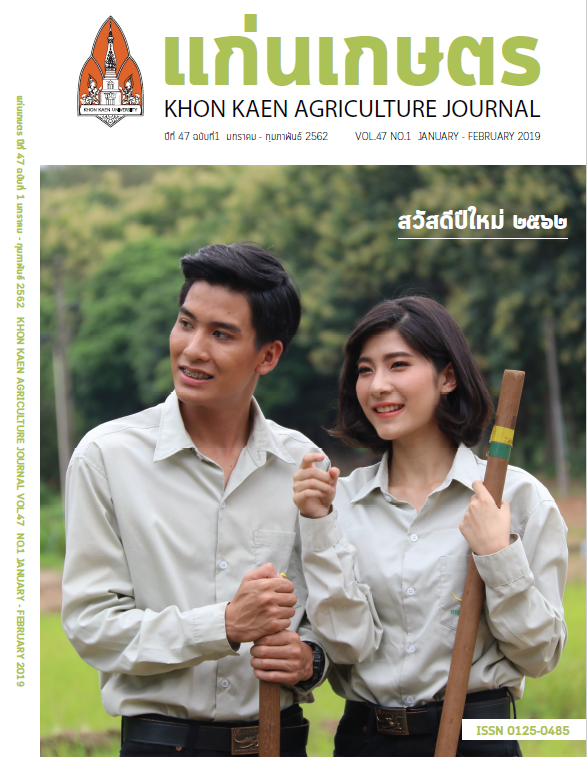Genetic parameter of sow longevity and sow lifetime prolificacy traits using purebred swine censored record
Main Article Content
บทคัดย่อ
The purpose of the present study was to investigate the indicators for improved sow longevity in a Thailand swine commercial nucleus herd. The sow longevities in this study were stayability in the 2nd - 5th parity (STAY2, STAY3, STAY4, and STAY5), lifetime (LT), lifetime production (LP), Productive per lifetime (PD%) and number born alive per lifetime day (NBA/LT). Lifetime and prolificacy records were from 3,148, 2,354, and 1,176 daughters of 306, 273 and 158 sires in purebred Landrace, Yorkshire, and Duroc, respectively. Sow records were collected between 2008 and 2016. Genetic parameters were estimated with a threshold model for stayability traits with THRGIBBS1F90. Genetic parameters for LT, LP, PD% and NBA/LT traits were estimated by Bayesian linear models with GIBBS2F90 and GIBBS2CEN considering censored records (record which animal are still alive when data collection occurred). The longevity and lifetime prolificacy were analyzed with bivariate analysis. Posterior means of heritability of stability were 0.14-0.28, 0.10-0.31, 0.10-0.39 and 0.14-0.38 in STAY2, STAY3, STAY4, and STAY5 respectively. Genetic correlations among these traits is positive 0.32-0.94 (STAY2-STAY5) and 0.77-0.98 (STAY3-STAY5). Heritability of longevity and lifetime prolificacy traits using GIBBS2F90 and GIBBS2CEN were 0.03-0.13 and 0.03-0.24 in LT, 0.21-0.29 and 0.21-0.29 in LP, 0.03-0.21 and 0.03-0.12 in PD% and 0.12-0.24 and 0.12-0.24 in NBA/LT. Heritability estimated with censored records was not only higher than it was when ignoring the censored records, but the -2log (p) was lower also. Thus, STAY3 and LP and NBA/LT breeding value estimated with ignoring the censored records are indicators for improved sow longevity and lifetime prolificacy in this commercial herd.
Article Details
เอกสารอ้างอิง
Abell, C. 2013. The use of selection to improve sow longevity. Grad. Theses Diss. Available from: http://lib.dr.iastate.edu/etd/13385
Engblom, L., J. A. Calderón Díaz, M. Nikkilä, K. Gray, P. Harms, J. Fix, S. Tsuruta, J. Mabry, and K. Stalder. 2016. Genetic analysis of sow longevity and sow lifetime reproductive traits using censored data. J. Anim. Breed. Genet. Z. Für Tierz. Zücht. 133:138–144.
Engblom, L., N. Lundeheim, A.-M. Dalin, and K. Andersson. 2007. Sow removal in Swedish commercial herds. Livest. Sci. 106:76–86.
Engblom, L., N. Lundeheim, M. D. P. Schneider, A.-M. Dalin, and K. Andersson. 2009. Genetics of crossbred sow longevity. Anim. Int. J. Anim. Biosci. 3:783–790.
Fernàndez de Sevilla X., E. Fàbrega, J. Tibau, and J. Casellas (2008). Effect of leg conformation on survivability of Duroc, Landrace, and Large White sows. J. Anim. Sci., 86: 2392–2400
Guo, S.-F., D. Gianola, R. Rekaya, and T. Short. 2001. Bayesian analysis of lifetime performance and prolificacy in Landrace sows using a linear mixed model with censoring. Livest. Prod. Sci. 72:243–252.
Knauer, M., K. J. Stalder, T. Serenius, T. J. Baas, P. J. Berger, L. Karriker, R. N. Goodwin, R. K. Johnson, J. W. Mabry, R. K. Miller, O. W. Robison, and M. D. Tokach. 2010. Factors associated with sow stayability in 6 genotypes. J. Anim. Sci. 88:3486–3492.
López-Serrano, M., N. Reinsch, H. Looft, and E. Kalm. 2000. Genetic correlations of growth, backfat thickness and exterior with stayability in large white and landrace sows. Livest. Prod. Sci. 64:121–131.
Lucia, T., G. D. Dial, and W. E. Marsh. 2000. Lifetime reproductive performance in female pigs having distinct reasons for removal. Livest. Prod. Sci. 63:213–222.
Mathur, P. (2002) Development of a recording and evaluation system for conformation traits. In: Proceedings of the National Swine Improvement Federation Conference and Annual Meeting. Nashville, TN, USA; 5th–6th December. Available at http://www.nsif.com/Conferences/2002/DevelopmentRecordingEvaluation.htm
Misztal, I., S. Tsuruta, T. Strabel, B. Auvray, T. Druet, and D. H. Lee. 2002. BLUPF90 and related programs (BGF90). Available from: http://orbi.ulg.ac.be/handle/2268/84980
Nikkilä, M. T., K. J. Stalder, B. E. Mote, M. F. Rothschild, F. C. Gunsett, A. K. Johnson, L. A. Karriker, M. V. Boggess, and T. V. Serenius. 2013. Genetic associations for gilt growth, compositional, and structural soundness traits with sow longevity and lifetime reproductive performance. J. Anim. Sci. 91:1570–1579.
Noppibool, U., M. A. Elzo, S. Koonawootrittriron, and T. Suwanasopee. 2015. Estimation of Genetic Parameters and Trends for Length of Productive Life and Lifetime Production Traits in a Commercial Landrace and Yorkshire Swine Population in Northern Thailand. Asian-Australas. J. Anim. Sci. Asian-Australas. J. Anim. Sci. 29:1222–1228. doi:2016.29.9.1222.
SAS Institute Inc. 2015. SAS/STAT 14.1 User’s Guide. Cary, NC. SAS Institute Inc
Serenius, T., and K. J. Stalder. 2004. Genetics of length of productive life and lifetime prolificacy in the Finnish Landrace and Large White pig populations. J. Anim. Sci. 82:3111–3117.
Serenius, T., and K. J. Stalder. 2006. Selection for sow longevity. J. Anim. Sci. 84 Suppl:E166-171.
Serenius, T., K. J. Stalder, and M. Puonti. 2006. Impact of dominance effects on sow longevity. J. Anim. Breed. Genet. 123:355–361.
Stalder, K. J., R. Curt, T. L. Cross, G. E. Conatser, and Ms. 2003. Financial impact of average parity of culled females in a breed-to-wean swine operation using replacement gilt net present value analysis. ResearchGate. 11:69–74.
Tsuruta, S., and I. Misztal. 2006. THRGIBBS1F90 for estimation of variance components with threshold and linear models. Proc. 8th World Congr. Genet. Appl. Livest.


